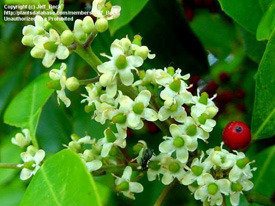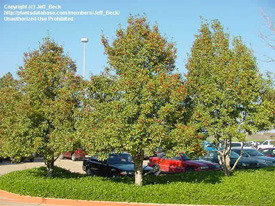Many people admire fruiting hollies in the winter when their brightly colored berries and dark green leaves brighten a garden which otherwise might be drab. Some people, however, choose not to plant hollies in their landscape because they remember the hard spines on the leaf margins of a holly that gave them grief at some time in their past.
American holly,
Ilex opaca, is like that. Prickly leaves are almost always on the ground, so walking barefoot underneath one is likely to cause injury to unprotected feet. Walking past one with low-hanging branches is sure to cause some scratches. If pruning must be done, long sleeves and sturdy gloves are the order of the day.
Better Choices for Home Landscapes
However, Southern gardeners do not have to settle for the prickly Ilex opaca. Gardeners in the southeastern United States and in similar climates can have hollies in their landscapes with just as many berries but far fewer spines along the leaf margins. If spines are present, they are soft and not likely to injure. We don’t have to search foreign shores to find these plants, for they are a cross of two of our native species. These interspecific hybrids, named Ilex ×attenuata, are a cross between Ilex opaca (American holly) and I. cassine (dahoon holly). These hybrids occur naturally where the ranges of the two species meet, and the resulting offspring are commonly referred to as topel holly. Several cultivars are commonly available and are likely to have different common names based on their cultivar names.  Exhibiting a variety of different forms and habits, these cultivars generally share certain characteristics. Bases and apices of the leaves taper gradually to a long, slender point (attenuated). When compared with American holly, the leaves are thinner and the fruit is typically smaller. In spring, insignificant greenish-white flowers bloom and are followed by green, pea-sized fruits which turn brilliant red and persist through fall and winter. Most of these plants are female, so berry production is assured. Some, however, may be parthenocarpic (produce berries without a male pollinator), but berry production is probably heavier when a male pollinator species is nearby. Fred Galle lists 46 cultivars of Ilex ×attenuata in his book, Hollies, the Genus Ilex.(1) Cultural Requirements
Exhibiting a variety of different forms and habits, these cultivars generally share certain characteristics. Bases and apices of the leaves taper gradually to a long, slender point (attenuated). When compared with American holly, the leaves are thinner and the fruit is typically smaller. In spring, insignificant greenish-white flowers bloom and are followed by green, pea-sized fruits which turn brilliant red and persist through fall and winter. Most of these plants are female, so berry production is assured. Some, however, may be parthenocarpic (produce berries without a male pollinator), but berry production is probably heavier when a male pollinator species is nearby. Fred Galle lists 46 cultivars of Ilex ×attenuata in his book, Hollies, the Genus Ilex.(1) Cultural Requirements
The tree hollies described in this article prefer acidic, moist, but well-drained soil and full sun to partial shade. However, all are drought tolerant and have moderate salt tolerance. Some have particular preferences, but generally speaking, they are adaptable to a wide range of conditions found in home landscapes in the Southeast.
Uses in the Landscape  These tree hollies have several potential landscape uses. They make a very suitable hedge or screening plant, but are equally suitable as specimen plants. Because of their narrow crowns, they make excellent street trees, and they grow well in the narrow spaces between the sidewalk and street. Eighteen species of birds, including songbirds, mourning doves, wild turkey, and bobwhite, eat the fruit. Small migrating flocks of small birds such as cedar waxwings can strip all the berries from a tall holly in a very short time. Deer, squirrels, and other small mammals also eat the berries, and cattle have been known to browse the foliage. Bees gather nectar from the flowers and use it to make an excellent honey.
These tree hollies have several potential landscape uses. They make a very suitable hedge or screening plant, but are equally suitable as specimen plants. Because of their narrow crowns, they make excellent street trees, and they grow well in the narrow spaces between the sidewalk and street. Eighteen species of birds, including songbirds, mourning doves, wild turkey, and bobwhite, eat the fruit. Small migrating flocks of small birds such as cedar waxwings can strip all the berries from a tall holly in a very short time. Deer, squirrels, and other small mammals also eat the berries, and cattle have been known to browse the foliage. Bees gather nectar from the flowers and use it to make an excellent honey.
If you have room in your landscape for a small to medium tree, one of the cultivars described in this article may be just the ticket. All are highly recommended for Southern gardens and other areas that share similar climatic and soil conditions. Plant one of these hollies for their evergreen leaves, colorful berries, and attractiveness to wildlife. Four Popular Cultivars of Ilex x attenuata ‘Savannah’Range: Zones 6-9Size: Medium tree 30-45 feet tall; 6-10 feet wideFoliage: medium to light green with multiple soft spinesForm: Narrow pyramidal to columnar; open canopied
‘East Palatka’Range: Zones 7A-9BSize: Medium tree; 30-45 feet tall; 10-15 feet wideFoliage: bright green with one spine at the tip of each leaf and few along the leaf bladeForm: tight pyramidal shape
‘Fosteri’ (Foster’s # 2, Foster’s holly)Range: Zones 6-9Size: Small tree 15-25 feet tall; 8-12 feet wideFoliage, small, glossy, very dark green; spiny marginsForm: Dense, pyramidal silhouette ‘Eagleston’Range: Zones 6-9Size: Small tree 18-25 feet tall and 6-10 feet wideFoliage: dark to medium green leaves with soft spinesForm: Pyramidal 1. Galle, Fred C., Hollies, the Genus Ilex; Timber Press, Portland, Oregon, 1997 Photograph credit to Jeff Beck, a Dave's Garden Contributor.






 Exhibiting a variety of different forms and habits, these cultivars generally share certain characteristics. Bases and apices of the leaves taper gradually to a long, slender point (attenuated). When compared with American holly, the leaves are thinner and the fruit is typically smaller. In spring, insignificant greenish-white flowers bloom and are followed by green, pea-sized fruits which turn brilliant red and persist through fall and winter. Most of these plants are female, so berry production is assured. Some, however, may be parthenocarpic (produce berries without a male pollinator), but berry production is probably heavier when a male pollinator species is nearby. Fred Galle lists 46 cultivars of Ilex ×attenuata in his book, Hollies, the Genus Ilex.(1) Cultural Requirements
Exhibiting a variety of different forms and habits, these cultivars generally share certain characteristics. Bases and apices of the leaves taper gradually to a long, slender point (attenuated). When compared with American holly, the leaves are thinner and the fruit is typically smaller. In spring, insignificant greenish-white flowers bloom and are followed by green, pea-sized fruits which turn brilliant red and persist through fall and winter. Most of these plants are female, so berry production is assured. Some, however, may be parthenocarpic (produce berries without a male pollinator), but berry production is probably heavier when a male pollinator species is nearby. Fred Galle lists 46 cultivars of Ilex ×attenuata in his book, Hollies, the Genus Ilex.(1) Cultural Requirements These tree hollies have several potential landscape uses. They make a very suitable hedge or screening plant, but are equally suitable as specimen plants. Because of their narrow crowns, they make excellent street trees, and they grow well in the narrow spaces between the sidewalk and street. Eighteen species of birds, including songbirds, mourning doves, wild turkey, and bobwhite, eat the fruit. Small migrating flocks of small birds such as cedar waxwings can strip all the berries from a tall holly in a very short time. Deer, squirrels, and other small mammals also eat the berries, and cattle have been known to browse the foliage. Bees gather nectar from the flowers and use it to make an excellent honey.
These tree hollies have several potential landscape uses. They make a very suitable hedge or screening plant, but are equally suitable as specimen plants. Because of their narrow crowns, they make excellent street trees, and they grow well in the narrow spaces between the sidewalk and street. Eighteen species of birds, including songbirds, mourning doves, wild turkey, and bobwhite, eat the fruit. Small migrating flocks of small birds such as cedar waxwings can strip all the berries from a tall holly in a very short time. Deer, squirrels, and other small mammals also eat the berries, and cattle have been known to browse the foliage. Bees gather nectar from the flowers and use it to make an excellent honey.